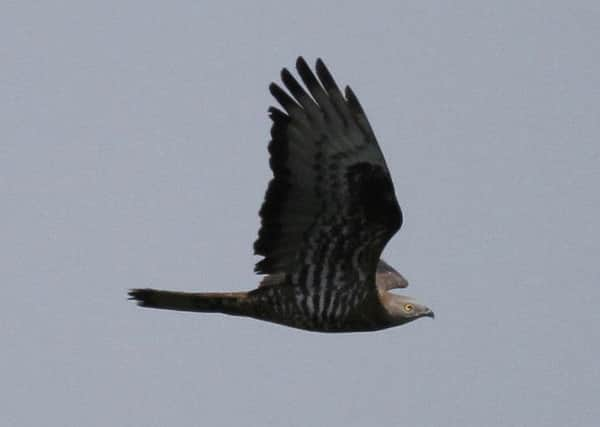Birdwatch: Sweet sight creates secret buzz above woodland canopies


Many sites are kept strictly secret but two places to watch honey buzzards are well-known to Yorkshire birders, the Wykeham Raptor Viewpoint in North Yorkshire and the Welbeck watch point at the side of the Clumber to Cuckney road just south of Clumber Park, North Nottinghamshire. Honey buzzards have been seen from both in the past few weeks.
Common buzzards are also seen at both places and it isn’t always easy to tell the two species apart.
Advertisement
Hide AdAdvertisement
Hide AdOne helpful feature is the different way they fly. When common buzzards are soaring or flying they almost always keep their wings slightly lifted whereas the honey buzzard’s wings are kept flat; even when they flap their wings they are seldom raised above their body.
Another difference is that the honey buzzard’s tail has two or three thick dark bands while the common buzzard’s tail has many dark bands.
Common buzzards spend a lot of time in the air looking for rabbits below but in summer honey buzzards are often on the forest floor looking for wasps and hornets. They use a long, sharp hind claw to dig up and rip open nests before eating the adults, pupae, larvae and even the comb. Feathers around the head and beak protect them from being stung.
Honey buzzards are common across Europe but are at the edge of their range in this country. There are up to 60 breeding pairs and some evidence of numbers increasing.
Advertisement
Hide AdAdvertisement
Hide AdHoney buzzards have a short breeding season and begin to leave for Africa again from mid-August. Sometimes, depending on the prevailing winds, British honey buzzards are joined by large numbers of birds from Scandinavia moving south and at these times individuals can turn up anywhere.
When this happens local common buzzards are scrutinised with extra care to see if a honey buzzard has joined them.
As the temperatures rose more bee-eaters were seen with a flock of 11 of these exotic birds flying south over the Bempton Cliffs reserve on Tuesday and others seen at Spurn with one on wires at Church Field for more than an hour.
There were brief sightings of a second-summer laughing gull, a vagrant from North America at Beacon Ponds and a whiskered tern at Bank Island, Wheldrake Ings.
Advertisement
Hide AdAdvertisement
Hide AdAfter several brief appearances a gull-billed tern was at Wader Scrape at Old Moor on Tuesday. The reserve stayed open until dusk to give more birders a chance to see it.
A marsh warbler, known for its mimicry of other birds, was singing at Sammy’s Point and a female red-necked phalarope was back on pools at Holderness Field, Kilnsea.
A drake ring-necked duck in full summer plumage was seen at Blacktoft Sands, a first for the reserve; a greenish warbler was singing in Flamborough while a Temminck’s stint was at Thornwick Pool. A possible Iberian chiffchaff was at the edge of an industrial estate at Eastfield, Scarborough.